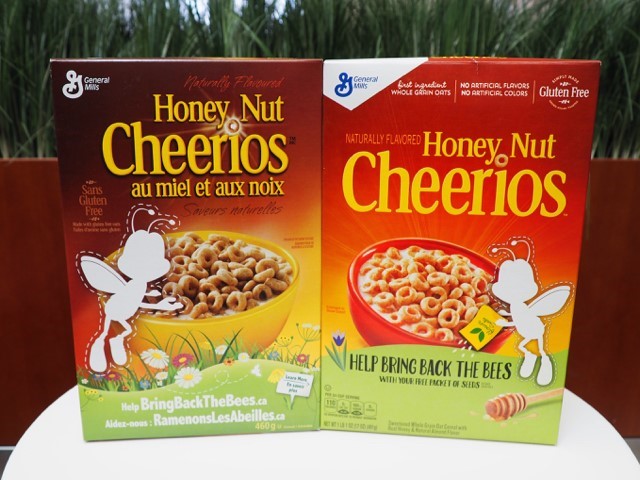Is Cheerios Really Saving Bees, or Is It Just PR Buzz?
By Austin Wilson and Zoey Olbum
At the beginning of the modern, health-conscious age, cereal giant General Mills faced a big problem. Traditional snacks and cereals were still profitable but were no longer growing in sales, as consumers of all kinds began to prefer healthier, more authentic food.
So, General Mills did two things. First they bought lots of organic and “natural” food brands that were already known by consumers, like Annie’s, and second, they made old brands more appealing by eliminating artificial ingredients and committing to sustainable agriculture.
Cheerios, one of General Mills’ most identifiable brands, is 77 years old and is still America’s most popular cereal—they gross $1 billion in sales per year. To show off their commitment to the environment, Cheerios launched a bold new ad campaign in 2016 called “Bring Back the Bees.”
The “Bring Back the Bees” campaign sought to raise awareness about declining pollinator populations. Bee Colony Collapse or Pollinator Decline is a complex issue; in short, bees and other insects are vital for global food production since they pollinate three-quarters of all crops. Their numbers are plummeting and scientists have determined that certain pesticides are a major reason why. Governments around the world, like the European Union, are beginning to ban toxic pesticides to protect our vital (and dwindling) population of both wild and commercial honeybees.
To “Bring Back the Bees,” Cheerios gave away millions of wildflower seeds and donated money to research. That’s all great, but there’s one big problem. The oats in Cheerios—and lots of other foods made by General Mills—are still being treated with bee-toxic pesticides.
It gets worse
To improve the whole company’s sustainability image, General Mills promised to sustainably source its 10 main ingredients by 2020. General Mills reports that it is 76 percent of the way there.
The corporation defines “sustainable sourcing” for most crops as “continuous improvement on environmental impacts.” However, General Mills is not gathering data on pesticide use, let alone reducing the use of bee-toxic pesticides.
General Mills is, however, gathering some data on how its crops are grown with the help of Field to Market, an alliance of big food companies. Field to Market has a tool for farmers to track things like greenhouse gas emissions and water use, but this tool does not record data on pesticide use. To further complicate the issue, pesticide companies like Syngenta and DowDuPont sit on Field to Market’s board of directors and its advisory committees, a clear conflict of interest.
Other companies are doing more
Dozens of major food and retail companies have adopted policies to restrict the use of bee-toxic neonicotinoids in their supply chains, including Whole Foods Market, Lowe’s, Walmart, Costco, Home Depot, and BJ’s Wholesale Club.
Food distributor Sysco reports yearly on the quantity of pesticides its policies have avoided, including the amount of pesticides that affect beneficial organisms such as pollinators.
It’s time General Mills gets up to speed with its competitors.
General Mills is playing a dangerous game
Should a company claim that 76 percent of its crops are sustainable—with “continuous improvement on environmental impacts”—when it’s not measuring pesticide use?
Should a company champion its support for bees without banning—or even reducing—bee-toxic pesticides?
We don’t think so. Consumers are getting more discerning, and they can lose trust in a brand like Cheerios pretty quickly. That loss of Cheerios’ valuable reputation is one of the reasons why we filed a shareholder resolution, which shareholders will vote on in September at its annual meeting in Minneapolis.
We urge General Mills to save the company, and really save the bees, by measuring and reducing pesticide use. Cheerios is a great brand, but it needs to keep consumer trust.
Here’s how the bees have been affected
Bees are so important to food crops (and the whole ecosystem) because many plants require the help of pollinators to reproduce. In fact, many plants simply cannot reproduce without the help of pollinators. Cross-pollination bees help at least 30 percent of the world’s crops and 90 percent of wild plants to thrive.
Insect pollinators—especially bees—are rapidly disappearing in Europe and North America, a loss that threatens food security and entire ecosystems. Scientists regard the overuse and misuse of pesticides as one of the main factors contributing to the decline of pollinators. Other factors include climate change, parasites and habitat loss.
Since 2006, researchers estimate that nearly one-third of all honeybee colonies in the U.S. have vanished. This crisis, called Colony Collapse Disorder, threatens the stability of the global food system in its entirety. You can say that again! Our adorable, buzzy friends are that crucial.
So how are the bees doing at this current juncture?
Not good. More than 700 North American bee species are headed toward extinction, and they’re headed there fast. A recent study found 75 percent of global honey tests contained insecticides and half contained a “cocktail of chemicals.” That is not a good outlook for our pollinator populations.
A 2017 study of bees native to North America found that nearly one in four bees is facing increasing risk of extinction. The study reveals that more than 40 percent of global pollinator populations are “highly threatened.” For many bee populations in decline, it is also likely these populations are declining at a rate close to or at the rate of extinction.
Imagine if we didn’t have any more of our wonderful pollinator friends to help us sustain our life as we know it. How sad that would be.
To donate and support our work eliminating toxic pesticides, click here.

